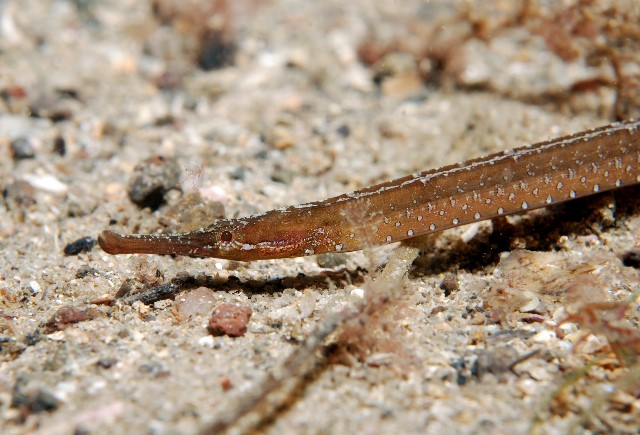- Classification
- ACTINOPTERYGII
- SYNGNATHIFORMES
- SYNGNATHIDAE
- Vanacampus
- margaritifer
Mother-of-pearl Pipefish, Vanacampus margaritifer (Peters 1868)

A Mother-of-pearl Pipefish, Vanacampus margaritifer, in Nelson Bay, New South Wales. Source: Dave Harasti. License: All rights reserved
A brown to greyish-brown pipefish with pale bars across the back, small pearly spots along the side and distinct pale markings on the ventral ridges. The Mother-of-pearl Pipefish has a long snout, a small tail fin and low ridges on the body.
Mother-of-pearl Pipefish, Vanacampus margaritifer (Peters 1868)
More Info
|
Distribution |
Endemic to sub-tropical and temperate Australia, from North Stradbroke Island, QLD, southwards to Jurien Bay, WA, absent from Tasmania. Inhabits shallow estuarine and coastal waters where it occurs in seagrass beds (including Heterozostera, Zostera, Posidonia and Halophila), macroalgae (Ecklonia and other brown algae), rocky reef, boulder, rubble, sandy and muddy habitats between 2–15 m. |
|
Features |
Dorsal fin 22–26; Pectoral fin 10–12; Anal fin 3–4; Caudal fin 10; trunk rings 18–20 (usually 18); tail rings 34–38; subdorsal rings 2.75–1.00 + 3.50–5.25 = 5.50–6.75 Body elongate, trunk shallow; head aligned with body, snout moderately long; median dorsal snout ridge not confluent with supraorbital ridge, longitudinal opercular ridge usually complete; superior trunk and tail ridges discontinuous near rear of dorsal-fin base; inferior trunk and tail ridges continuous; lateral trunk ridge not confluent with tail ridges; tail not prehensile. Dorsal fin slightly closer to tip of snout than to tip of tail, base of moderate length; anal fin tiny, below anterior portion of dorsal fin; caudal fin small. |
|
Size |
To at least 16.5 cm, and possibly to 20 cm. |
|
Colour |
Body overall brown, usually with 12–13 pale bars about 1 ring wide on upper surface of body, separated by darker interspaces 3–5 rings wide; side with pearly spots or ocelli on lateral and inferior ridges and scutella of each trunk ring. |
|
Feeding |
Species in the genus Vanacampus feed on small crustaceans, especially mysid shrimps and cladocerans, sucked in through the long tubular snout. |
|
Biology |
Males brood the eggs in an enclosed pouch on the underside of the tail just behind anal fin; males may be brooding at 129 mm SL; may have up to 160 eggs per brood. The larvae hatch at about 10 mm in length; body rings are present at an early stage, anal fin reduced. |
|
Fisheries |
The Mother-of-pearl Pipefish is of no interest to fisheries or aquaculture. |
|
Conservation |
Australian Commonwealth legislation: Marine listed under the Environment Protection and Biodiversity Conservation Act 1999 (EPBC Act). State Legislation: Listed as protected under the New South Wales, Victorian, Tasmanian and South Australian Fisheries Management Acts. |
|
Similar Species |
Vanacampus margaritifer differes from the similar Vanacampus phillipi in usually having fewer tail rings (34-38 versus 38-46) and in subadults-adults having a regular arrangement of pale spots on the trunk rings (spots are absent or irregular in Vanacampus phillipi). In addition Vanacampus margaritifer tends to have a longer snout and brooding males tend to have more pouch eggs (100 versus <50 in Vanacampus phillipi). |
|
Etymology |
The specific name margaritifer is from the Latin margarita (pearl) in reference to the pearly spots on the body. |
|
Species Citation |
Syngnathus margaritifer Peters 1868, Mber. K. Preuss. Akad. Wiss. Berlin 1868: 457. Type locality: Sydney (NSW). |
|
Author |
Bray, D.J. & Thompson, V.J. 2017 |
Mother-of-pearl Pipefish, Vanacampus margaritifer (Peters 1868)
References
Dawson, C.E. 1984. Synopsis of Australian Pipefishes usually referred to the Syngnathine (tail-pouch) genera Syngnathus, Leptonotus and Histiogamphelus. Mem. Mus. Vic. 45: 71–123.
Dawson, C.E. 1985. Indo-Pacific Pipefishes (Red Sea to the Americas). Gulf Coast Research Laboratory, Ocean Springs, Mississippi. 230 pp.
Kuiter, R.H. 1993 Coastal Fishes of South-eastern Australia. Crawford House Press, Bathurst, 437 pp.
Kuiter, R.H. 2008. Family Syngnathidae (pp. 448-479). In Gomon, M.F., D.J. Bray & R.H. Kuiter. (Eds.) Fishes of Australia's Southern Coast. New Holland Press & Museum Victoria, Melbourne, Australia, 928 pp.
Kuiter, R.H. 2009. Seahorses and their relatives. Aquatic Photographics, Seaford, Australia. Pp. 1–333.
Parker, P.G. 1999. Fish Assemblages at Julian Rocks and the adjacent waters of northern New South Wales, Australia. Australian Zoologist 31(1): 134–160.
Paxton, J.R. , J.E. Gates, D.F. Hoese & D.J. Bray. 2006. Syngnathidae (Pp. 810–846). In Hoese, D.F,. Bray, D.J., Paxton, J.R., Allen, G.R, Beesley, P.L. & Wells, A. (Eds) Zoological Catalogue of Australia. Volume 35. Fishes. ABRS & CSIRO Publishing, Australia., 3 vols.
Peters, W.C.H. 1868. Über eine neue Nagergattung Chiropodomys penicillatus, so wie über einige neue oder weniger bekannte Amphibien und Fische. Mber. K. Preuss. Akad. Wiss. Berlin 1868: 448–460.
Pogonoski, J.J., D.A. Pollard & J.R. Paxton. 2002. Conservation Overview and Action Plan for Australian Threatened and Potentially Threatened Marine and Estuarine Fishes, Environment Australia, Canberra. 375 pp.
Rachinski, T. & Pollom, R. 2016. Vanacampus margaritifer. The IUCN Red List of Threatened Species 2016: e.T65375519A67622365. http://dx.doi.org/10.2305/IUCN.UK.2016-1.RLTS.T65375519A67622365.en. Downloaded on 18 March 2017.




